|
The
|
|||||||||||||||||||||||||||||||||||
THE BURGENLAND BUNCH NEWS - No. 285 March 31, 2018, © 2018 by The Burgenland Bunch All rights reserved. Permission to copy excerpts granted if credit is provided. Editor: Thomas Steichen (email: tj.steichen@comcast.net) BB Home Page: the-burgenland-bunch.org BB Newsletter Archives: BB Newsletter BB Facebook Page: TheBurgenlandBunchOFFICIAL Our 22nd year. The Burgenland Bunch Newsletter is issued monthly online. It was founded by Gerald Berghold (who retired from the BB in the Summer of 2008 and died in August 2008). |
|||||||||||||||||||||||||||||||||||
| Current Status Of The BB: * Members: 2627 * Surname Entries: 8257 * Query Board Entries: 5718 * Staff Members: 16 |
|||||||||||||||||||||||||||||||||||
|
|||||||||||||||||||||||||||||||||||
1) THE PRESIDENT'S CORNER (by Tom Steichen)  This
month's collection of bits and pieces in Article 1 tells us of the
passing of true "Austrian" community leader, Bob Wolf, of new records available online at
FamilySearch and GenTeam, and about Austrian naturalization rates... plus a few more
things! This
month's collection of bits and pieces in Article 1 tells us of the
passing of true "Austrian" community leader, Bob Wolf, of new records available online at
FamilySearch and GenTeam, and about Austrian naturalization rates... plus a few more
things!Article 2 came out of a conversation with Richard Potetz about an article that claimed 2017 was The Year Consumer DNA Testing Blew Up ...but the statistician in me asked, ...Or Was It? Have a read and see what you think. Article 3 is right out of the current Burgenland news, being based on a report that the European Court of Justice had rejected a 2013 Hungarian land law, one in which the slogan supporting the law was Hungarian Soil in Hungarian Hands! My article gives some of the back story as well as showing that the decision wasn't as cut-and-dried as the news stories implied. Article 4 covers in detail a topic that all of us have struggled with; that is, the seemingly endless Variants in the Spelling of Our Ancestral Surnames. I credit BB Members Editor, Gerald Gamauf, for sharing the link to a most interesting article by Dr. Anna Lea Staudacher, who has specialized in the how and why of changing surnames. The remaining articles are our standard sections: Historical Newsletter Articles, and the Ethnic Events and Emigrant Obituaries sections. 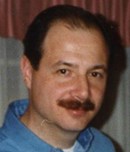 Former
President of the Donau Club in New Britain, CT, has died: Robert William Wolf Jr.,
66, of New Britain, CT, passed away on Thursday, March 8, 2018. Born in New Britain, he was the
son of the late Robert W. Wolf Sr. and Clelia (Palazzo) Wolf. Robert was a Trustee and
former President of the Donau Club in New Britain, where he was also in charge of
Austrian Cultural Heritage and in promoting Austrian cultural traditions. At the Donau
Club, he established a library, which contains German language books and magazines. Robert
loved all things Austrian, and traveled to Austria and Germany many times. Robert was proud to
have family in Minihof-Liebau and Vienna, Austria. Memorial donations may be made to the Donau
Club, 545 Arch St., New Britain, CT 06051. The online guest book is at
www.ericksonhansen.com. Former
President of the Donau Club in New Britain, CT, has died: Robert William Wolf Jr.,
66, of New Britain, CT, passed away on Thursday, March 8, 2018. Born in New Britain, he was the
son of the late Robert W. Wolf Sr. and Clelia (Palazzo) Wolf. Robert was a Trustee and
former President of the Donau Club in New Britain, where he was also in charge of
Austrian Cultural Heritage and in promoting Austrian cultural traditions. At the Donau
Club, he established a library, which contains German language books and magazines. Robert
loved all things Austrian, and traveled to Austria and Germany many times. Robert was proud to
have family in Minihof-Liebau and Vienna, Austria. Memorial donations may be made to the Donau
Club, 545 Arch St., New Britain, CT 06051. The online guest book is at
www.ericksonhansen.com.Additional Digitized LDS Films:  Additional
Burgenland-area microfilms have been released for access this past month. Of the 29 missing
films from Burgenland proper, an additional 12 are now online, reducing the missing count to 17
entries. That is, 1240 of 1259 films (98.5%) are online in digital format. Of the 34 missing
films for the Hungarian border area that we list, an additional 15 are now online, reducing that
missing count to 19, so 475 of 494 films (96%) are now online. Our LDS pages (at
http://www.the-burgenland-bunch.org/LDS/LDS.htm) have been updated to document these
additional films and provide links to the images. Additional
Burgenland-area microfilms have been released for access this past month. Of the 29 missing
films from Burgenland proper, an additional 12 are now online, reducing the missing count to 17
entries. That is, 1240 of 1259 films (98.5%) are online in digital format. Of the 34 missing
films for the Hungarian border area that we list, an additional 15 are now online, reducing that
missing count to 19, so 475 of 494 films (96%) are now online. Our LDS pages (at
http://www.the-burgenland-bunch.org/LDS/LDS.htm) have been updated to document these
additional films and provide links to the images. Of the 36 microfilms remaining to be converted, 7 are Lutheran, 14 are Catholic, 7 are Civil and 8 are Military. We will, of course, monitor these unconverted microfilms and add the digital collection numbers and links when they become available. She is the first and currently only member whose admittance to the BB is based solely on DNA evidence. As members, you should know that we require reasonable evidence of an ancestral tie to the Burgenland region before we grant membership so, obviously, we think the DNA evidence is compelling. We also intend to tell you more about that evidence in the near future... but not yet, as efforts are currently underway to assist Alicia in learning more about her Burgenland ancestors ...when her story is complete, we will share it. More Naturalizations in Burgenland and Austria: Statistics Austria reports that the number of naturalizations in Austria rose again in 2017. More than 9,000 people were granted Austrian citizenship in 2017, including 187 in Burgenland. Although this Burgenland count corresponds to a 10 percent increase compared to the year before, it is, nevertheless, the lowest absolute number of naturalizations among the Austrian federal provinces. Since 2010, the annual number of naturalizations in Burgenland has remained constant at 0.7 percent of the population, much lower than its 6% all-time high rate in 2002. Across Austria, the number of naturalizations increased by 7.5 percent compared to 2016. 9,271 citizenships were granted, with 35 percent of all naturalized citizens being born in Austria and 37 percent being under 18 years of age. The largest group of new Austrians (around 1,300) had previously been citizens of Bosnia and Herzegovina, followed by Turkey (779), Kosovo (664), Serbia (557) and Afghanistan (424). Since the 2003 record year for Austrian naturalizations (with 45,112 cases), 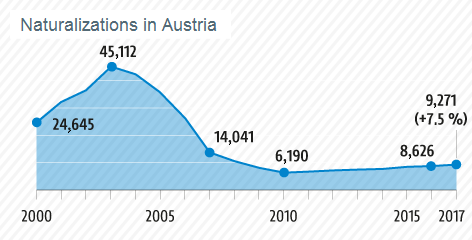 the
number of naturalizations had fallen dramatically, reaching 6,190 in 2010, its lowest value
ever. Since 2011 (6,754), the numbers rose again. The provisional naturalization rate—the
rate of naturalization of persons resident in Austria in relation to persons of non-Austrian
nationality living in Austria—was 0.7 percent in 2017, as in the previous year. the
number of naturalizations had fallen dramatically, reaching 6,190 in 2010, its lowest value
ever. Since 2011 (6,754), the numbers rose again. The provisional naturalization rate—the
rate of naturalization of persons resident in Austria in relation to persons of non-Austrian
nationality living in Austria—was 0.7 percent in 2017, as in the previous year.In 2017, more persons were naturalized in six of the nine federal states compared to 2016. The growth was most pronounced in Vienna (plus 27.6 percent, to 3,899 naturalizations), followed by Lower Austria (plus 14.3 percent, to 1,319), Carinthia (plus 13.7 percent, to 358) and Burgenland (plus ten percent, to 187). 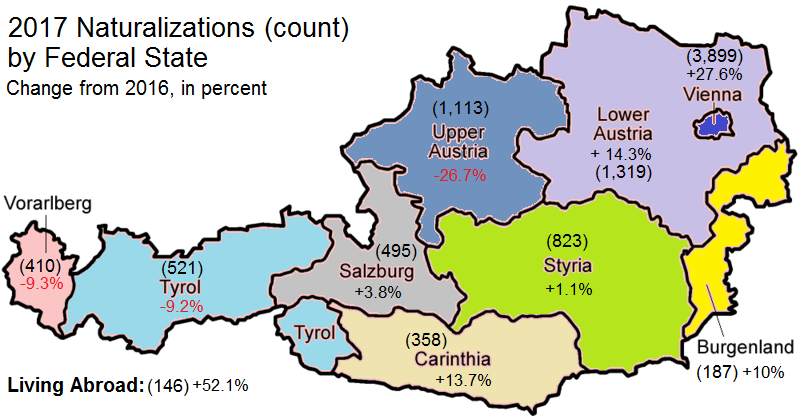 Smaller increases, compared to the previous year, were recorded in Salzburg (plus 3.8 percent, to 495) and Styria (plus one percent, to 823). In the other three federal states, there were fewer naturalizations in 2017 than in the previous year: Upper Austria (minus 26.7 percent, to 1,113), Vorarlberg (minus 9.3 percent, to 410) and Tyrol (minus 9.2 percent, to 521). Thus the increases were along the main emigration routes into Austria and in the industrialized areas around Vienna, with the decreases in the more rural, mountainous areas.  New
Records at GenTeam, www.GenTeam.eu: GenTeam is an
European platform containing genealogical data. All data at GenTeam is free of charge, though
you must register. GenTeam currently has 18.2 million entries online and 39,600 registered users
(including me!). New
Records at GenTeam, www.GenTeam.eu: GenTeam is an
European platform containing genealogical data. All data at GenTeam is free of charge, though
you must register. GenTeam currently has 18.2 million entries online and 39,600 registered users
(including me!). 750,000 additional entries were added online this cycle, including: -- Register Indices from Burgenland: added Dörfl, Oberloisdorf, Steinberg, Unterrabnitz, Wimpassing an der Leitha. -- Austria-Hungary WW-1 Military Casualty Lists: 610,000 of ~3.5 million entries now online. -- Vienna Baptism Index, 1585-1915: Entries from 8 parishes added. -- Vienna and Surroundings Catholic Marriage Index: extended to 1938 (begins 1542).  Update
for book "The Burgenländer Emigration to America": Here is this month's update on
purchases of the English issue of the 3rd edition of Dr. Walter Dujmovits' book "Die
Amerika-Wanderung Der Burgenländer." Update
for book "The Burgenländer Emigration to America": Here is this month's update on
purchases of the English issue of the 3rd edition of Dr. Walter Dujmovits' book "Die
Amerika-Wanderung Der Burgenländer."Current total sales are 1278 copies, as interested people purchased 10 more books during this past month. As always, the book remains available for online purchase at a list price of $7.41 (which is the production charge for the book, as we purposely choose not to make a profit so we can avoid dealing with the income tax consequences and so you can obtain the book at as low a cost as possible!), plus tax & shipping. See the BB homepage for a link to the information / ordering page and for any current discounts (and there is at least one discount on price or shipping available most of the time... if not, wait a few days and there will be one!). Burgenland Recipes: This recipe comes from Bob Jerin, an organizer of tours to Croatia. A number of Burgenländers still identify as Croatian, and this recipe uses vegetables in place of the peppers in its better-known neighbor from Hungary. 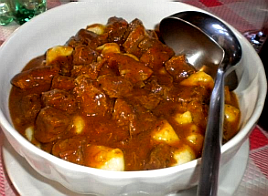 CROATIAN GOULASH
CROATIAN GOULASH(from Bob Jerin) Ingredients: 2 tablespoons oil 12 small onions, chopped 1 clove garlic, chopped 1 pound beef, cubed 1/2 pound pork, cubed 6 ounce can tomato paste Salt, pepper, cayenne pepper, to taste 1 teaspoon paprika 1 bay leaf 6 medium-sized potatoes, cubed 1 cup chopped celery 1 cup grated carrots 3 tablespoons flour 3 tablespoons water Instructions: Heat the oil in a large pot and add finely chopped onions. After a few minutes, add garlic. Cut the meat into cubes and, when the onions turn golden, add the meat to the pot. Turn up the heat a bit and mix until the meat is browned on all sides. Spoon tomato paste on top of the meat mixture, add enough water to cover the meat, and blend all ingredients together. Add salt, pepper, cayenne pepper and paprika and blend again. Finally, place a bay leaf on top. Cover the pot and let it simmer, stirring occasionally. After 50 minutes, check to see if the meat is tender. After the meat is tender, add potatoes, chopped celery and grated carrots. Again turn down the heat and cover the pot. When the potatoes are soft, add mix of 3 tablespoons of flour and warm water, stirring while adding to the stew. While doing that you can take the pot off the heat entirely so that the flour doesn’t get lumpy. Once you’ve done that, put it back on the stove on a low temperature, mix well, cover, and cook for a few more minutes.  Reminder:
We no longer have a "regular" source for Burgenland recipes. As evidenced above, a few readers
have shared favorite family recipes, and we do have a reserve for a couple of months now, but if
contributions stop coming in, we'll be begging again! So, please consider sharing your favorite
Burgenland recipes or recipe books with us. Our older relatives sadly aren't with us forever, so
don't allow your allow your favorite ethnic dishes to become lost to future generations. Send
your suggestions to BB Recipes Editor,
Alan Varga. Thanks! Reminder:
We no longer have a "regular" source for Burgenland recipes. As evidenced above, a few readers
have shared favorite family recipes, and we do have a reserve for a couple of months now, but if
contributions stop coming in, we'll be begging again! So, please consider sharing your favorite
Burgenland recipes or recipe books with us. Our older relatives sadly aren't with us forever, so
don't allow your allow your favorite ethnic dishes to become lost to future generations. Send
your suggestions to BB Recipes Editor,
Alan Varga. Thanks!Cartoon of the Month: 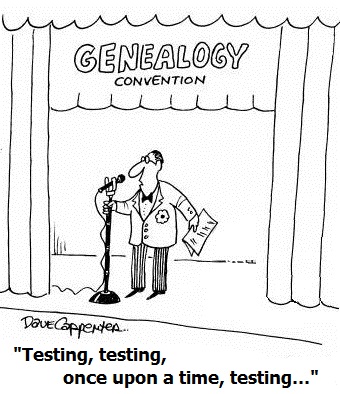 |
|||||||||||||||||||||||||||||||||||
2) 2017: THE YEAR CONSUMER DNA TESTING BLEW UP! ...OR WAS IT? Recently, Richard Potetz sent me a note saying: Hi Tom, I remember when it was a big deal to identify someone in your DNA Relatives list. Now many of my cousins have been tested. This article below puts numbers on what was just an impression of mine. Genealogy and genetic genealogy seem to be merging. The article he referred to is titled "2017 was the year consumer DNA testing blew up" and was written by Antonio Regalado and published in the online MIT Technological Review, dated February 12, 2018. The article can be found here: technologyreview.com/s/610233. I replied to Richard (in part): I wanted to respond to your note, as the chart in the referenced article is one that the statistician in me recognizes as somewhat deceptive (i.e., you can make it seem to say things that are not quite accurate). This is the chart I’m speaking of: 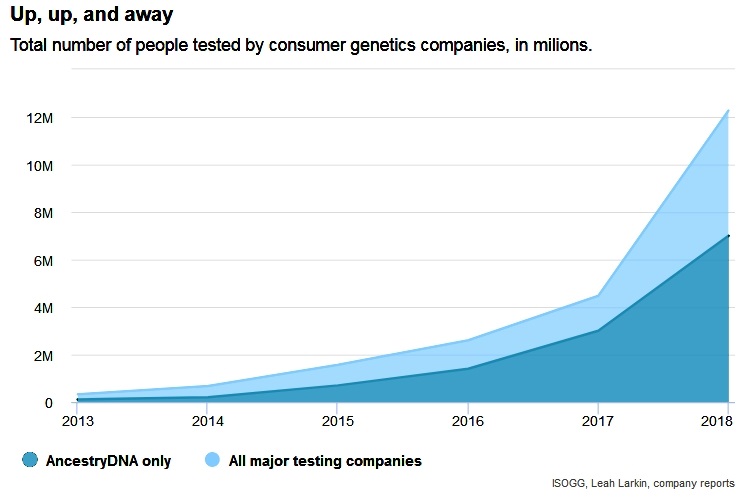 The author uses it to “support” the contention of the title of his article, “2017 was the year consumer DNA testing blew up.” But is 2017 really the year testing “blew up”? What the chart shows is data that is effectively doubling each year (at least a statistical test would not say otherwise given the little bit of data that is available!). In fact, the yearly rate of increase is pretty much the same, regardless of which year you speak of. You can show this by redrawing the data, dropping off a year at a time. Below are some Excel charts where I do that, keeping the y-scale span pretty much the same and the yearly gap equal (the first chart is the data as shown above, then I drop a year at a time): 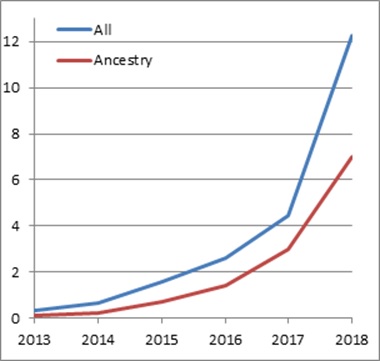
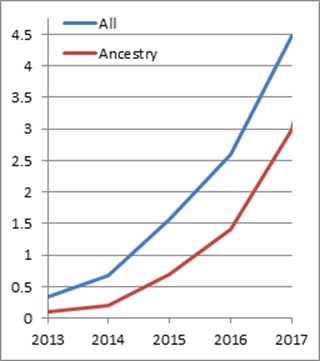
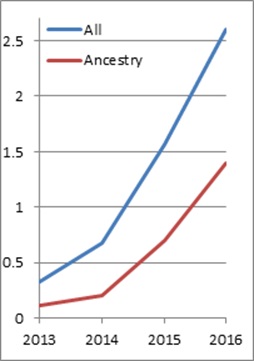
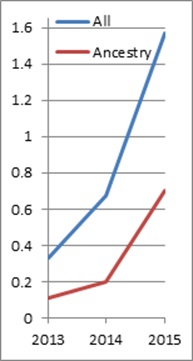 So, looking at those, which year “blew up”? If you actually look at the data and then calculate rate of change from one year to the next (Rate), you get this:
...where the last two columns are the calculated yearly proportional Rates of increase.
|
|||||||||||||||||||||||||||||||||||
3) HUNGARIAN SOIL IN HUNGARIAN HANDS! 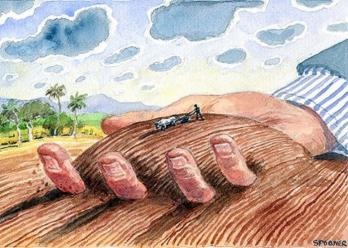 The
title to this article was the slogan attached to a 2013 Hungarian land law,
effectively banning non-Hungarians from owning or having beneficial rights
to the use of Hungarian land. The
title to this article was the slogan attached to a 2013 Hungarian land law,
effectively banning non-Hungarians from owning or having beneficial rights
to the use of Hungarian land. The law is: "2013. évi CXXII. törvény a mezo- és erdogazdasági földek forgalmáról" (Law 122, 2013: The Sale of Agricultural and Forestry Land), the text of which can be found online (in Hungarian) here: net.jogtar.hu/...docid=A1300122.TV. The reason the law is of interest to us is that it was recently rejected by the European Court of Justice (ECJ) after a EU Commission sued Hungary for failing to comply with EU rules on the rights of foreign investors. It also harkens back to a principle that was essential to our ancestral Burgenländers (be they ethnic Germans, Croatians or Magyars) in their peasant past: usufruct, the right to enjoy the use and advantages of another’s property short of the destruction or waste of its substance. In the ‘seigneurialism’ system that our peasant ancestors lived under (it was not serfdom, though it is easy to call it that), they owed dues and services to their lord in return for established rights, in particular the right to profit from the use of the lord's land. This is little different from the modern practice of renting or leasing land or an apartment: you get the benefit of the crops grown on the land or of the living space in the apartment ...but you can't destroy either. A peasant under ‘serfdom’ could possibly possess such a right but actually owed dues and services merely by virtue of his legal status relative to the lord. [For more information about this, I'll refer you to the 2-part 2016 BB Newsletter article found here: 270#4 and 271#4.] As some background, Victor Orbán, Hungarian Prime Minister since 2010 and leader of his Fidesz party, declared in 2010 that "Foreigners will never buy land here" (as long as he and his party were in power). That led to the 2013 law and, soon after, complaints from the EU leadership, as land contracts and leases longer than 20 years were barred and considered invalidated by the new law. Thus, foreign farmers lost legally-acquired usufruct rights to Hungarian agricultural land. Others affected included foreigners who bought usufruct rights to a garden, orchard or vineyard, which often affected Austrians, particularly Burgenländers, who were inclined to lease such in nearby areas across the border. All those who were not able to demonstrate close ties to the Hungarian landowner had their rights canceled after a transitional period of only four and a half months (instead of the previously announced 20-year transitional period). Such usufruct rights were unilaterally terminated, without compensation, starting 1 May 2014, around four and a half months after the entry into force of the Land Act. The owners of the usufruct rights were then deleted from the land registers. The EU Commission initiated its lawsuit before the ECJ in October 2014, arguing that investors had made investment decisions as a result of the longer transitional period, saying: "The new law now seems to deprive them of their acquired rights and the value of their investments." They also criticized the short-term unilateral termination of leases. Orbán argued back in 2015 that, "Without land in Hungarian hands, there could be no future for the country." The ECJ disagreed, calling the Hungarian law a breach of EU law and declaring that Hungary was in violation of its wider-reaching law. The Court reasoned that removing legally-acquired usufruct rights from people who were not close relatives of agricultural land owners in Hungary is an indirect discriminatory restriction on the free movement of capital, which is not justified. Hungary argued that its 2013 measures merely sanctioned violations of preexisting national rules by foreign purchasers of the usufruct rights, but this reasoning was rejected by the Court (even though there was some basis for this argument). As early as 1994, Hungary had banned foreigners from buying Hungarian land. Hungary wanted to protect itself from cheap, speculative land purchases by foreign investors. Therefore, purchasers skirted the ban via repeating 20-year lease agreements and the Hungarian landowners evaded it by usufruct contracts in which the Hungarian landlord granted the usufruct rights to the land to a foreign beneficiary for life or 99 years. In contrast to leases, the entire usufructuary price was paid when the contract was initiated, so, for the current Hungarian owner, the contract was effectively a sale and the ban was totally evaded. The 2013 land law annulled all these contracts.  These
contracts had repeatedly been described by Hungarian politicians as "pocket contracts" in which
land had been bought in Hungary by circumventing the existing Hungarian legislation. They
accused foreigners, above all Austrians, of securing cheap agricultural land over the past two
decades through Hungarian "straw men" (Hungarians who bought the land merely to lease or
contract it out, not to work it). But, from the point of view of foreign investors, these leases
and contracts were legally concluded and, in one case, even confirmed by the Hungarian
Supreme Court. Thus the ECJ ruled against the 2013 law. These
contracts had repeatedly been described by Hungarian politicians as "pocket contracts" in which
land had been bought in Hungary by circumventing the existing Hungarian legislation. They
accused foreigners, above all Austrians, of securing cheap agricultural land over the past two
decades through Hungarian "straw men" (Hungarians who bought the land merely to lease or
contract it out, not to work it). But, from the point of view of foreign investors, these leases
and contracts were legally concluded and, in one case, even confirmed by the Hungarian
Supreme Court. Thus the ECJ ruled against the 2013 law. |
|||||||||||||||||||||||||||||||||||
4) OF VARIANTS IN THE SPELLING OF OUR SURNAMES BB Members Editor, Gerald Gamauf, shared a link to an interesting article referenced on austria-forum.org (and found here: austria-forum.org/.../Varianten_von_Familiennamen): "Von Varianten in der Schreibweise unserer Familiennamen," by Dr. Anna Lea Staudacher. As you can tell by its title (its translation is my title), it is a German-language article, however you can easily get the gist of it via GoogleTranslate (and yes, it will mess some things up, but most of it translates reasonably well). More importantly, most of it applies to the muddle of Burgenland name variations we observe every time we dig into our family histories. 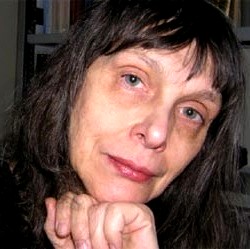 Dr.
Staudacher earned an undergraduate degree in German and history at the University of Vienna in
1972, completed work in political science, history and Romance studies at the University of
Lausanne, earning a Diploma of Aptitude for the Teaching of Modern French in 1976, and
then returned to the University of Vienna for a Doctorate in History in 1981. She has been based
at the University of Vienna and/or the Austrian Academy of Sciences for most of her career, with
study visits to other universities and research organizations sprinkled throughout. Her work
spanned a complex subject area that includes onomatopoeia (making or creating names) in
the broader sense (including converts, foundlings, name changes and shifts), as well as Jewish
history, precise identification and interpretation of archival material, writing and paleography
(authenticating ancient scriptures). Her writings are broad, though concentrated on Jewish
history and names. Dr.
Staudacher earned an undergraduate degree in German and history at the University of Vienna in
1972, completed work in political science, history and Romance studies at the University of
Lausanne, earning a Diploma of Aptitude for the Teaching of Modern French in 1976, and
then returned to the University of Vienna for a Doctorate in History in 1981. She has been based
at the University of Vienna and/or the Austrian Academy of Sciences for most of her career, with
study visits to other universities and research organizations sprinkled throughout. Her work
spanned a complex subject area that includes onomatopoeia (making or creating names) in
the broader sense (including converts, foundlings, name changes and shifts), as well as Jewish
history, precise identification and interpretation of archival material, writing and paleography
(authenticating ancient scriptures). Her writings are broad, though concentrated on Jewish
history and names.Below is my interpretation of, and comments on, her article... Dr. Staudacher begins her article by stating that "the spelling of surnames was only fixed at the end of the 19th century: before then, a name was recorded as it 'sounded', i.e., as the writer understood [or heard it]." If I were to quibble with that statement, it would be to argue that claiming a single hard before/after cutpoint is questionable... the (intended) establishment of fixed surnames varied from place to place and was met with mixed results, at best, where it was (theoretically) imposed. What is true is that formal surname changes documented in local court records are relatively rare prior to 1900. Even though the practice of using surnames was well established in German lands by the 1500s, Baden, in 1790, was the first German state to require fixed surnames ...by 1820 that requirement was almost universal in the German states. The Hungarian surname system, for the most part, came into existence during the 14th-16th centuries, but legislation requiring fixed family names wasn't passed until 1787. Legislation for legally changing a surname was passed in 1814, but that process remained largely unused until late in the century. Nonetheless, we know that having a required fixed surname did not mean it would be written the same way every time! Staudacher notes that trouble reading names, even on formal government documents, existed from early on, especially if one didn't know what a given name should be (we see this problem in transcribed records frequently!). And, if several copies of a document were required, the copies were made in specialized "copyist" offices, where one person dictated and another (or others, if multiple copies were needed) wrote, and those writers interpreted the dictated names in their own ways. Staudacher states that, "in general, one endeavored to hold a name so that it was recognizable in the sound." Thus, in the multi-ethnic state of the monarchy, the numerous spelling variants of names was due to the dialect of the writer alone; syllables and endings were swallowed (deleted) or added as needed. Further, she notes that many names in the German language ended in -er (in particular names of professions and origin), and this ending could easily be "swallowed", but an ethnic name like Mosing sounded nobler (more German) as Mosinger, and adding an inconspicuous -er was also a sign of a successful integration; thus Hönigshof became Hönigshofer. An additional variant occurs when pre-19th-century gender-identifying surnames were misinterpreted in more modern times (that is, after surnames became gender-neutral). For example, Staudacher explains, the surname Huef was once written Huefin when referring to a female... the modern reader must know that the -in suffix must be dropped. This problem was exacerbated in gender-identifying Slavic names, as illegitimate children were identified by the mother's surname. Thus, for example, if Eleonore Woticka, daughter of Joachim Woticky, had an illegitimate son named Albert, he was registered as Albert Woticka, after his mother; you must know that the family surname was really Woticky. Staudacher gives many additional examples of how surnames changed: The unstressed e between two consonants could be "swallowed", especially at the end of the word, as in the ending -el: Mand(e)l, Gerst(e)l ...but also in the middle: Hutt(e)rer, Eng(e)lhart ...even syllables could disappear: Blum(en)feld, Alm(en)stetter. Conversely, individual letters or sounds could also be added to maintain the "phonetic picture" of a name as it was heard; a b appearing between m and s, Samstag became Sambstag, and Gams became Gambs, and then Gamps. The substitution of soft and hard closing sounds (b and p) occurred frequently: Blonski–Plonski, Probst–Propst, Korb–Korp, ...also d and t: Dänzer–Tänzer, Leinhard–Leinhart; less frequently g and k were exchanged: Gahn–Kahn, Ludwig–Ludwick. Variations also occurred due to the interchangeability of certain vowels depending on dialect, such as a and o: Walfisch–Wolfisch, Kapper–Kopper, Barvil–Borvil. The change from a to e was rarer, but still occurred: Jamnitzer–Jemnitzer, Ungar–Unger. Even o and u: Politzer–Pulitzer, Cohn–Kuhn. Even the closed vowels e and i interchanged: Leon–Lion, Morawetz–Morawitz. Umlaut vowels, ä, ö and ü, alternated with the similar-sounding simple vowels, e and i respectively, says Staudacher: Kämpf–Kempf, Färber–Ferber, Mändel–Mendel; Hecht–Höcht, Geppert–Göppert, Schüller–Schiller, Würth–Wirth. And ö could also change with the diphthong eu: Schöringer–Scheuringer, or again with ai, ay, ei, or ey: Breuer–Breyer–Breier. Further, eu and äu were interchangeable: Käusch–Keusch. Writing variants (same pronunciation, different scriptualization) were also common, for example, k and ck: Ekstein–Eckstein; c before a, o and u with k: Cantor–Kantor, Cohn–Kohn. Double consonants changed often with their simple form: Pope–Poppe, Bata–Batta, Ofenbach–Offenbach, Bramer–Brammer, Bruner–Brunner, Schor–Schorr. Staudacher says the most common was the changes from l to ll, as in Balner–Ballner, Kolinsky–Kollinsky and s with ss, as ss was written in the Latin script for the German sharp ß: Jasniger–Jassnüger–Joßnüger. In the multi-ethnic state of the Austro-Hungarian monarchy, non-German names were Germanized, or German names adapted to Slavic and Magyar spellings: Polacek–Pollatschek, Spitzer–Spiczer, Salzberger–Szalczberger, Zwillinger–Cvilinger. Until 1941, the Kurrentschrift (Kurrent-script handwriting) was closely related to the German language, with Latin script used in a Kurrentschrift text only for foreign words and names, or to highlight dates or amounts of money. Not infrequently, the juxtaposition of both writing systems led to errors and thus to name changes, says Staudacher.  One
problem was that the long s in the round (Latin) script
looked too much like a Kurrent h (see top image to right), and when combined with
a round s to represent the sharp-ß of Kurrentschrift, a name like
Strauss (lower image) in the round script could be misread as Strauhs. Her
example was that Jassnüger became Jahsnüger. One
problem was that the long s in the round (Latin) script
looked too much like a Kurrent h (see top image to right), and when combined with
a round s to represent the sharp-ß of Kurrentschrift, a name like
Strauss (lower image) in the round script could be misread as Strauhs. Her
example was that Jassnüger became Jahsnüger.In the Kurrentschrift, u, n and e are often confusingly similar, barely distinguishable 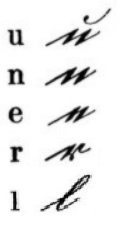 from
one another, says Staudacher (see image to right). Thus name variations with n and u
were created, Tanz–Tauz, Zikan–Zikau, as well as with e and u:
Speller–Spuller and Zelzer–Zulzer. from
one another, says Staudacher (see image to right). Thus name variations with n and u
were created, Tanz–Tauz, Zikan–Zikau, as well as with e and u:
Speller–Spuller and Zelzer–Zulzer.If in the Latin script, the tab of r was pulled down too far onto the line, this could create an n, or vice versa, if the tab on n remained hanging, Jonas becomes Joras, and Kröpfelmacher becomes Knöpfelmacher. A too-short l could mutate into an e, as in Campbell–Campbele or Iltis–Ietis, and after an i as in Pilpel–Piepel. An l could also be seen as t, or vice versa, as in Huppert–Hupperl, Schotz–Scholz. Now and then a lush e was read as o, or an o became so narrow that it could be interpreted as e as in Perdan–Pordan. An e could be reduced to c, or a c could turn into an e through italicization: Pick–Piek, Massock–Massoek–Massök; and relatively often misread in sch: Schilo–Sehilo. Staudacher also notes that a writer with a Slavic mother tongue could easily see the -er ending as -cz; he only needed to take the e as an italic c, then the subsequent familiar z easily replace the -r ending, thus Zerner–Zerncz. Umlaut vowels sometimes changed place with the basic vowel, and too often for such a change to be attributed to the negligence of a scribe who simply failed to add the umlaut mark: Wahringer–Währinger, Loser–Löser, Burger–Bürger. A u-Haken (that curved line above a Kurrent u) could dissolve into a tilde form (another way to indicate an umlaut, but also to indicate an abbreviation), say Staudacher, or into a line (used to indicate a repeat of the character it was above), resulting in new name forms. It seems to have made absolutely no difference whether a name was written (or spoken) with or without the umlaut, she says. Letters were also exchanged: David Gelber became David Gebler, and i often slipped a place: Weiner–Wiener, Meiser–Mieser, Freidmann–Friedmann and Corolani–Corolain. Even capital letters were not unassailable, for example, the Kurrent C, in its age-old form, was pretty similar to today's L. Thus Camilla became Lamilla, and Cohn, Lohn. A whole series of capital letters were exchanged with each other, B and R in Bessel–Ressel, J and T in Jaussig–Taussig, K with H in König–Hönig, M and W in Mettendorfer–Wettendorfer, and F and T as in Fritsch–Tritsch and Fischler–Tischler. But things could get even worse, she says, as in Ilitsch–Nitsch, in which I and l (capital 'eye' and lowercase 'el') merged into an N! To make it easier to find a particular line in a text when transferring names, scribes often placed a piece of paper or a ruler under the line they were about to copy. This piece of paper or ruler now obscured the descenders, so only what was written above the line was read, i.e., what was left of letters such as g, j, p, x and y (in the old form): thus Lustig–Lustia, Porjes–Pories, Fux–Fua, Brody–Broda, Krzepicki–Krzehicki. Lastly, swapped associations sometimes played a role in the oral as well as in the written recording of names, as in Barndorf–Barnfeld, Felsenberg–Felsenbach, Seywald–Seywall, Buchfelder–Buchwälder, Deblanco–Delbanco. This is where Dr. Staudacher leaves off, but I can imagine that, if there was yet another way to mess up a name, someone did it (and likely more than once)! Coincidentally this past month, I had someone write to me about a number of almost similar surnames in a village and ask if I could advise on their etymology. Based on personal experience with Burgenland records, I replied that, "as for etymology, I don’t believe there are unequivocal paths... rather, random diversions in naming that roll back to their beginnings every so often. There were just too many influences (languages, governments, churches, etc.) on the form of written names for there to be a single evolutionary path." I'm glad to see that Dr. Staudacher's writings seemingly support that opinion! |
|||||||||||||||||||||||||||||||||||
5) HISTORICAL BB NEWSLETTER ARTICLES Editor: This is part of our series designed to recycle interesting articles from the BB Newsletters of 10 years ago. Below is an article from 10 years ago [with an added editorial note by me] that revolves around a letter, translated by Fritz Königshofer, from a grandmother far away in the Banat to a granddaughter living in America. I chose it, first, because of the letter's pathos and, secondly, because it provides opportunity for a tiny teaching moment. As you will see, the grandmother's location in the Banat—Puszta Krakás—was not recognized by Fritz, who is very skillful in finding such places ...but had he looked for "Krakáspuszta" he would have found it. THE BURGENLAND BUNCH NEWS - No. 173 March 31, 2008 EARLY IMMIGRANT CORRESPONDENCE - ZARTLER FAMILY, TORONTAL (courtesy Jack Fritz, Fritz Königshofer) Member Jack Fritz writes: Several weeks ago, I found the attached letter and am not sure if or how it relates to our family. The only clues that it might relate is the name Zartler at the upper left hand corner of page one and that the greeting on page one might be to Gisela, my grandmother. It appears to come from a town, Torontal, in Hungary. The date appears to be 17 December 1902, which would be about the time that my grandmother emigrated to Chicago. I appreciate all of the help that you have given me and hope to be of some help to the BB. Fritz Königshofer writes: Let me mention the letter you sent me for transcription and interpretation. As I had written earlier, the letter was addressed to Gisela from her grandparents Andreas and Agnes Zartler. From your earlier e-mails, I assume that Gisela was your grandmother. Therefore, this letter was written by your great-great-grandmother. Gisela and her parents lived in the USA, because Agnes writes of her plans to travel "home," where she was not expecting to see Gisela. The letter was sent from a place called Puzta [Puszta] Krakás in Torontál County of pre-WW-I Hungary. This was far away from Neumarkt, today likely in either Serbia or Romania. While I have very good village lists and atlases, I have been unable to find a place called Puszta Krakás. However, since the name is very clearly written, I feel that we'll eventually find out where it was located. 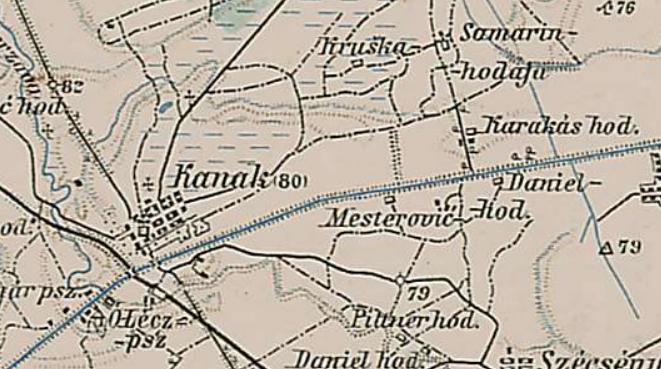 However,
a look at the 1910 version of the 3rd Military Mapping Survey of Austria-Hungary does not
show the place ...but there is a 'Karakás hod(ája)' that seems the likely location; no
other listed place within the Kanak hotter / municipality (if I can call it
that) appears to be a viable alternative. A hodája was defined as "a farm, a
self-contained building on the puszta" (per Réka Keisz: originally from a Serbian word and
now a part of the Hungarian language as hodály, meaning a large, spacious building
(usually a barn-type) to hold animals, host concerts, etc.), so it follows that the place might
be known locally as Krakáspuszta / Puszta Krakás. Like the 1910 map, earlier maps also
fail to show the place under name Krakáspuszta, implying it may have existed
officially by that name for only a short while; nothing remains there today.] However,
a look at the 1910 version of the 3rd Military Mapping Survey of Austria-Hungary does not
show the place ...but there is a 'Karakás hod(ája)' that seems the likely location; no
other listed place within the Kanak hotter / municipality (if I can call it
that) appears to be a viable alternative. A hodája was defined as "a farm, a
self-contained building on the puszta" (per Réka Keisz: originally from a Serbian word and
now a part of the Hungarian language as hodály, meaning a large, spacious building
(usually a barn-type) to hold animals, host concerts, etc.), so it follows that the place might
be known locally as Krakáspuszta / Puszta Krakás. Like the 1910 map, earlier maps also
fail to show the place under name Krakáspuszta, implying it may have existed
officially by that name for only a short while; nothing remains there today.]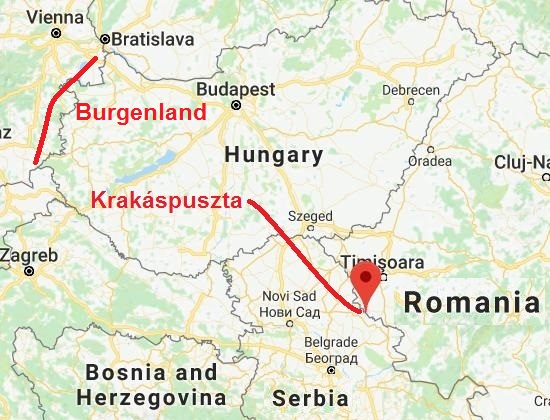 Andreas
Zartler (your great-great-grandfather) was serving as a "manorial [or domain] overseer" (uradalmi
ispán) of this place. Probably, he was in the service of an aristocratic family that owned
the place. It may have been a manorial farm ("Meierhof"), or a hunting estate, or even a
manor and its grounds, where the aristocratic family lived. It is possible that the same family
also had possessions in or around Neumarkt from where the family knew about the capabilities of
your great-great-grandparents and had asked them to manage their estate in Torontál county.
Otherwise, the letter speaks for itself. Let me give you a reading of the original (translated): Andreas
Zartler (your great-great-grandfather) was serving as a "manorial [or domain] overseer" (uradalmi
ispán) of this place. Probably, he was in the service of an aristocratic family that owned
the place. It may have been a manorial farm ("Meierhof"), or a hunting estate, or even a
manor and its grounds, where the aristocratic family lived. It is possible that the same family
also had possessions in or around Neumarkt from where the family knew about the capabilities of
your great-great-grandparents and had asked them to manage their estate in Torontál county.
Otherwise, the letter speaks for itself. Let me give you a reading of the original (translated):
|
|||||||||||||||||||||||||||||||||||
6) ETHNIC EVENTS LEHIGH VALLEY, PA Saturday, April 14: Stiftungsfest of the Edelweiss Schuhplattlers at the Reading Liederkranz. Info: www.readingliederkranz.com Saturday, April 14: Ein Abend in Wien at the Lancaster Liederkranz. Info: www.lancasterliederkranz.com Sunday, April 15: Spring Concert at the Reading Liederkranz. Entertainment by the Reading Liederkranz Singers, guest German choruses, and the Joseph Weber Orchestra. Info: www.readingliederkranz.com Sunday, April 15: Winteraustreiben at the Germansville Fire Co. in Germansville. Sponsored by The Pastorius Home Association. Music by the Josef Kroboth Orchestra. Info: (610) 767-6981. Sunday, April 22: Oktoberfest in April at Stokesay Castle in Reading. Sponsored by The Missionary Sisters of the Most Sacred Heart. Music by the Josef Kroboth Orchestra. Info: www.mscreading.org Saturday, April 28: Spring Concert of the Lancaster Liederkranz Chorus at Zion Evangelical Lutheran Church in Landisville. Info: www.lancasterliederkranz.com NEW BRITAIN, CT Friday, April 6, 7 pm: Heimat Abend. Austrian Donau Club, 545 Arch Street, $3. Music by Frank Billowitz. Friday, April 20, 7:30 pm: Heurigan Abend. Austrian Donau Club, 545 Arch Street, $3. Music by Schachtelgebirger Musikanten. |
|||||||||||||||||||||||||||||||||||
7) BURGENLAND EMIGRANT OBITUARIES Aloys Timar  Aloys
"Louie" Timar, 91, formerly of Nazareth, Pennsylvania, passed away peacefully at Alexandria
Manor of Nazareth on Thursday, March 1, 2018. Aloys
"Louie" Timar, 91, formerly of Nazareth, Pennsylvania, passed away peacefully at Alexandria
Manor of Nazareth on Thursday, March 1, 2018.A son of the late Joseph and Maria (Skrapits) Timar, Louie was born in Stockertown, Pennsylvania, on Oct. 20, 1926 and raised in Szentpéterfa (Petrovo Selo/Prostrum) Hungary. He worked for Hercules Cement in Stockertown for many years until his retirement at age 62. He was a member of Holy Family Catholic Church of Nazareth. Before moving to Pennsylvania in 1973, Louie, his wife Louise and two daughters lived in Brooklyn, NY. Louie spent his childhood in Hungary with his siblings and was cared for by his grandparents while his parents remained in the United States to work. When he was a young man, he returned to the U.S., where he later married and started a family. Louie lost his wife Louise in 2010 after a courageous battle with cancer. He is survived by daughter Nancy and husband Craig Boller of Lower Mount Bethel Twp., PA; daughter Sue and husband Gordy Ross of Bushkill Twp., PA; four grandchildren, Jessica, Stephanie, Eric and Sara; and six great-grandchildren. Also surviving are his sister, Theresa Zaboretzky of Queens, NY; four nieces and two nephews. He was predeceased by his two brothers, Joseph and Rudy. Louie enjoyed spending time with his family and especially loved telling stories of growing up in Europe. He enjoyed a good shot of "slivovitz," a glass of wine or a cold beer when someone came to visit. He was always happy-go-lucky. His favorite advice was "langsam," which means slowly, or take it easy, which would lead to a longer life. Dad, you certainly took your own advice. You touched so many people with your infectious smile and sincerity. We will miss you. We raise a glass to you, Dad. Nasdrovia! Services will be on Monday, March 5, 2018 at 10:30 a.m. in the Joseph F. Reichel Funeral Home, Inc. 220 Washington Park, Nazareth, PA 18064. Followed by a Mass of Christian Burial at 11 a.m. in Holy Family Church of Nazareth. Entombment is in Holy Family Mausoleum, Nazareth. Calling hours will be Monday from 9 to 10:30 a.m. in the funeral home. In lieu of flowers, donations may be made to Holy Family Church, in c/o the funeral home. Online condolences may be offered at jfreichelfuneralhome.com. Joseph Reichel Funeral Home 220 Washington Park Nazareth, PA 18064-2634 (610) 759-0160. Published in The Express Times from Mar 2 to Mar 3, 2018 Joseph Oswald  Joseph
Oswald, 90, of Germantown, Wisconsin, was born to eternal life on March 17, 2018. Joseph
Oswald, 90, of Germantown, Wisconsin, was born to eternal life on March 17, 2018.Joe passed peacefully with his family at his bedside and, per his wishes, the church bells rang in his hometown of Kirchfidisch, Austria, to let all those in the village know that he is now in heaven. Beloved husband of Mary Ann (née Johannik) for 63 years and loving father of John (Suzie) Oswald, Diane (Al) Holtz, Denis (Julie) Oswald and Lori Oswald. He is also survived by his eight grandchildren: Dan Oswald, Andy (Sarah) Oswald, Tony (Amanda) Oswald, Joe Holtz, Kayte Holtz, Cayla Holtz, Shelby (fiance Ben) Oswald and Cory (Sammy) Oswald and four great-grandchildren: Maddie, Lilly, Grant and Robert Oswald. Dear brother of Hermine Hansl of Austria. Dear brother-in-law of Elizabeth Gagliano. Further survived by many relatives and friends. After working 30 plus years, Joe retired from the House of Home Made Sausage. Joe's family would like to thank all the special people of Hometown Hospice for helping us honor his wishes in his final days. We would also like to thank Dr. Steven Merry and his nurse, Ellen, Dr. Kumar Sujeet and Julie for all their wonderful care. Family will receive relatives and friends on Saturday, March 24, 2018 at St. Mary's Church, N89 W16297 Cleveland Avenue, Menomonee Falls from 10:00 am until time of Mass of Christian Burial at noon. Entombment at St. Mary's Cemetery immediately following. As Joe was a Korean War Veteran and received assistance from the VA, in lieu of flowers, please make a donation to "Milwaukee VA/GPF #9074" in Joseph Oswald's name. The donation can be mailed to: Milwaukee VA, Attn: Voluntary Services, 5000 W. National Ave., Milwaukee, WI. 53295. Published in Milwaukee Journal Sentinel on Mar. 21, 2018 Theresia Vanderpoel (née Joseph)  Theresia
Vanderpoel, age 94, of De Pere, Wisconsin, entered her heavenly home on March 27, 2018. Theresia
Vanderpoel, age 94, of De Pere, Wisconsin, entered her heavenly home on March 27, 2018.Born October 1, 1923 in Hannersdorf, Austria, she was a daughter of the late Adolph and Maria (Schöck) Joseph. In 1936, Theresia and her family left Austria and made Chicago their new home. While Theresia's heart was always in "the old country," she grew to love city life in Chicago and lived there for the next 50 years. Theresia married Allen "Jack" Vanderpoel and they had two sons, John and Allen. Theresia worked at AT&T and State Farm Insurance before retiring and moving to De Pere at the age of 62. She was a Sunday School teacher and librarian at St. John's Lutheran School in Chicago, and volunteered in her grandchildren's classrooms at Dickinson Elementary in De Pere. Theresia was a member of Hope Lutheran Church. Above all else, Theresia was a woman of faith and family. She loved to bake, paint, draw, sing, play her guitar, sew, and crochet. She was the picture of good health nearly all her life, never drove anywhere she could walk to, and spent hours in her vegetable and flower gardens. Theresia was a strong, loving, and honorable woman, who loved the Lord and had a fantastic sense of humor, as well as a bit of an Austrian stubborn streak. We loved her beyond words and will miss her dearly. Survivors include Theresia's two sons, John and Allen, and Allen's wife, Juanita (Deterding); six grandchildren and their spouses: Joe and Kim Vanderpoel, Julie and Justin Hoerth, Jamie and Todd Olsen, and Caleb, Jacob, and Ethan Vanderpoel; and five great granddaughters: Annaleise, Elin, and Tess Hoerth, and Penelope and Frankie Olsen. Theresia was preceded in death by her beloved parents, Adolph and Maria, and her husband, Jack. She is also believed to be preceded in death by her brother, Adolph Joseph, who was POW/MIA in the Korean War. RYAN FUNERAL HOME, De Pere is assisting the family. The family will honor Theresia's life with a private memorial service. To our sweet mom and grandma, we love you. "Always have, always will." Now rest, you've lived a life to be proud of. Published in Green Bay Press-Gazette on Apr. 1, 2018 |
|||||||||||||||||||||||||||||||||||
| END OF NEWSLETTER (Even good things must end!) |
|||||||||||||||||||||||||||||||||||
NOTICE (Informal Terms and Conditions): The Burgenland Bunch (BB) was formed and exists to assist Burgenland descendants in their research into their heritage and, toward that end, reserves the right to use any communication you have with us (email, letter, phone conversation, data upload, etc.) as part of our information exchange and educational research efforts. ● If you do not want your communication to be used for this purpose, indicate that it is "confidential" and we will attempt to abide by that request. ● Correspondents who communicate with the BB without requesting confidentiality retain their copyright but give a non-exclusive license to the BB allowing us to forward to BB members, publish in our monthly newsletter or on our website, and/or subsequently and permanently archive all or parts of such communications. The formal Burgenland Bunch Website Usage Agreement can be found here: Agreement The Burgenland Bunch homepage (website) can be found at: the-burgenland-bunch.org Burgenland Bunch Newsletter, copyright © 2018 by The Burgenland Bunch All rights reserved. Permission to copy excerpts granted if credit is provided. |
 News
News